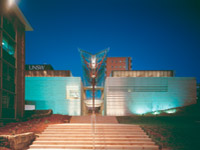| Arts (Media & Comms) / Law - 4764 |
|
||||||||||||||||||||||||||||||||||||||||

Program Summary
This program combines the professional Bachelor of Laws with the Bachelor or Arts (Media and Communications).
The Bachelor of Arts (Media and Communications) emphasises new computer-based multimedia skills and focuses on Australian media industries in relation to globalisation. The degree is vocationally relavant in its orientation and all students are given significant practical experience in new computer-based multimedia communications technologies. It aims to develop in students a sophisticated understanding of the history, scope and socio-cultural impact of new media technologies, and of the debates that have accompanied their development and use. Second, it offers extensive experience in the production of new media content appropriate for employment in the contemporary media. Note: This degree combination would be of interest to students interested in becoming media lawyers, or in the fields of broadcast media (video based, multi media production and post production; research, administration and policy analysis for private corporations, telecommunications companies and government departments.
Program Objectives and Learning Outcomes In addition to studying 8 courses in the Media and Communications core program, students complete 6 courses from List A of the Faculty of Arts and Social Sciences, to permit them to study a second field in depth. Years 1 and 2 cover multimedia writing and production and contextual media studies. Year 3 consolidates the program's emphasis on production and analytical skills. This grounding enables students to interpret, create and apply the products of the new media not only in the context of the mass information and entertainment industries, but also in a variety of other public and private sector areas such as education, on-the-job training and specialised information services.
Total Unit Requirements
An approved sequence of study can be found here:
Plan for Arts (Media & Comms)/ Law 4764 For details of the available Media & Communications courses, please refer to the Bachelor of Arts program, 3400. A direct link is given below: Bachelor of Arts 3400 General Education Requirements Students enrolled in a combined law degree are not required to complete general education courses.
Honours in the BA Program
Students wishing to take the BA(Media and Communications) degree program at Honours level must obtain prior approval from the relevant Schools in the Faculty of Arts and Social Sciences and the Faculty of Law. At least one and possibly two additional years of study are required. Alternatively students may consider completing the BA degree program at Honours level (4 years) and then seeking admission to the three year LLB degree program for graduates. See program 4790 for academic rules relating to the Bachelor of Laws Program. A direct link is given below;
Bachelor of Laws 4790 For information regarding fees for UNSW programs, please refer to the following website: https://my.unsw.edu.au/student/fees/FeesMainPage.html
|
|||||||||||||||||||||||||||||||||||||||||

| Contacts | Library | myUNSW | WebCT |